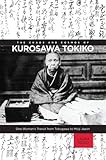The Chaos and Cosmos of Kurosawa Tokiko : One Woman's Transit from Tokugawa to Meiji Japan / Laura Nenzi.
Material type: TextPublisher: Honolulu : University of Hawaii Press, [2015]Copyright date: ©2015Description: 1 online resource (240 p.) : 12 b&w images, 5 mapsContent type:
TextPublisher: Honolulu : University of Hawaii Press, [2015]Copyright date: ©2015Description: 1 online resource (240 p.) : 12 b&w images, 5 mapsContent type: - 9780824839574
- 9780824853891
- 952.025092 23
- online - DeGruyter
- Issued also in print.
| Item type | Current library | Call number | URL | Status | Notes | Barcode | |
|---|---|---|---|---|---|---|---|
 eBook
eBook
|
Biblioteca "Angelicum" Pont. Univ. S.Tommaso d'Aquino Nuvola online | online - DeGruyter (Browse shelf(Opens below)) | Online access | Not for loan (Accesso limitato) | Accesso per gli utenti autorizzati / Access for authorized users | (dgr)9780824853891 |
Browsing Biblioteca "Angelicum" Pont. Univ. S.Tommaso d'Aquino shelves, Shelving location: Nuvola online Close shelf browser (Hides shelf browser)

|

|

|

|

|

|

|
||
| online - DeGruyter Traces of the Sage : Monument, Materiality, and the First Temple of Confucius / | online - DeGruyter Exile in Colonial Asia : Kings, Convicts, Commemoration / | online - DeGruyter Women Pre-Scripted : Forging Modern Roles through Korean Print / | online - DeGruyter The Chaos and Cosmos of Kurosawa Tokiko : One Woman's Transit from Tokugawa to Meiji Japan / | online - DeGruyter Romancing Human Rights : Gender, Intimacy, and Power between Burma and the West / | online - DeGruyter Hokusai’s Great Wave : Biography of a Global Icon / | online - DeGruyter Tea in China : A Religious and Cultural History / |
Frontmatter -- Contents -- Acknowledgments -- Introduction: The Flight of a Sparrow -- Part I Tokiko's World -- 1. A Nest and a Nexus -- 2. Circles and Circumstances -- Part II The Chaos and Cosmos of Kurosawa Tokiko -- 3. Glimpses of History (The Script) -- 4. From Script to Stage -- 5. Caged Bird -- 6. The Chaos and Cosmos of Kurosawa Tokiko -- 7. Transitions -- Part III Memory, Manipulation, and Amnesia -- 8. Rescuing The Past from the Present -- 9. The Many Reincarnations of Kurosawa Tokiko -- 10. Circles Redrawn: The View from 1930s Mito -- 11. Encores: New Scripts -- Conclusion The Doing That Matters -- Appendix -- Notes -- Bibliography -- Index -- About the Author
restricted access online access with authorization star
http://purl.org/coar/access_right/c_16ec
The Chaos and Cosmos of Kurosawa Tokiko is the story of a self-described "base-born nobody" who tried to change the course of Japanese history. Kurosawa Tokiko (1806-1890), a commoner from rural Mito domain, was a poet, teacher, oracle, and political activist. In 1859 she embraced the xenophobic loyalist faction (known for the motto "revere the emperor, expel the barbarians") and traveled to Kyoto to denounce the shogun's policies before the emperor. She was arrested, taken to Edo's infamous Tenmachō prison, and sentenced to banishment. In her later years, having crossed the Tokugawa-Meiji divide, Tokiko became an elementary school teacher and experienced firsthand the modernizing policies of the new government. After her death she was honored with court rank for her devotion to the loyalist cause.Tokiko's story reflects not only some of the key moments in Japan's transition to the modern era, but also some of its lesser-known aspects, thereby providing us with a fresh narrative of the late-Tokugawa crisis, the collapse of the shogunate, and the rise of the Meiji state. The peculiar combination of no-nonsense single-mindedness and visionary flights of imagination evinced in her numerous diaries and poetry collections nuances our understanding of activism and political consciousness among rural nonelites by blurring the lines between the rational and the irrational, focus and folly. Tokiko's use of prognostication and her appeals to cosmic forces point to the creative paths some women constructed to take part in political debates and epitomize the resourcefulness required to preserve one's identity in the face of changing times. In the early twentieth century, Tokiko was reimagined in the popular press and her story was rewritten to offset fears about female autonomy and to boost local and national agendas. These distorted and romanticized renditions offer compelling examples of the politicization of the past and of the extent to which present anxieties shape historical memory. That Tokiko was unimportant and her loyalist mission a failure is irrelevant. What is significant is that through her life story we are able to discern the ordinary individual in the midst of history. By putting an extra in the spotlight, The Chaos and Cosmos of Kurosawa Tokiko offers a new script for the drama that unfolded on the stage of late-Tokugawa and early Meiji history.
Issued also in print.
Mode of access: Internet via World Wide Web.
In English.
Description based on online resource; title from PDF title page (publisher's Web site, viewed 02. Mrz 2022)


